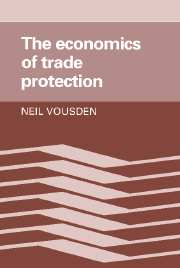8 - Endogenous protection
Published online by Cambridge University Press: 18 December 2009
Summary
In the previous chapters of this book we have been largely content to treat protection policies as something which are exogenously determined. Admittedly, we have frequently considered how a government might choose a policy to achieve a given non-economic (or income-distributional) objective, and we have ranked policies on the basis of their efficiency in achieving such an objective. However, the manner in which the objective is determined has remained unclear. Indeed (terms-of-trade arguments aside), we have not even begun to explain why tariffs and other impediments to trade exist in the first place. For example, if free trade is the optimal situation for a small country, why do we not observe groups or individuals who stand to lose from a tariff using lump-sum transfers to bribe tariff proponents to support free trade? Relative to a tariff, no-one would be worse off, and many would be better off. In a system of majority voting with perfect information, costless lump-sum transfers and zero voting costs, the transfers could be adjusted so that those who are better off under free trade always constitute a majority – free trade would win every time. The reality is that redistributions are costly, and political markets are not perfect. There are clear gainers and losers associated with any form of protection, and it would be unusual in practice for the former to compensate the latter to any great degree. Indeed, the standard theories of the income-distributional effects of tariffs, the Stolper–Samuelson theorem and the specific factors model (see Chapter 1), implicitly assume that no such compensation occurs.
- Type
- Chapter
- Information
- The Economics of Trade Protection , pp. 177 - 200Publisher: Cambridge University PressPrint publication year: 1990

